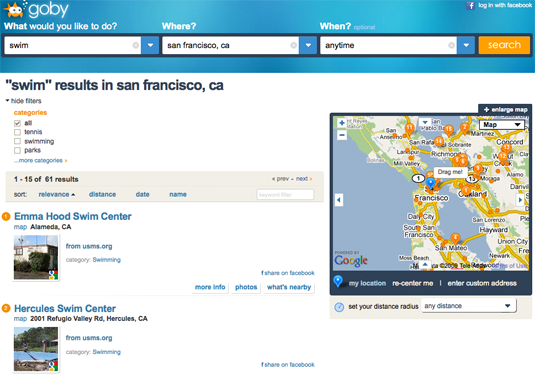 Looking for something to do? Starting now, you can look to Goby, a new search engine that launched Tuesday night. Rather than trying to beat Google at its own game, Goby is trying to be really good at one thing: helping you find places to go and activities to participate in–whether they’re in your own backyard or halfway around the world. That includes everything from trails to hike to museums to visit to hotels you might want to stay at.
Looking for something to do? Starting now, you can look to Goby, a new search engine that launched Tuesday night. Rather than trying to beat Google at its own game, Goby is trying to be really good at one thing: helping you find places to go and activities to participate in–whether they’re in your own backyard or halfway around the world. That includes everything from trails to hike to museums to visit to hotels you might want to stay at.
Goby’s search field is actually three search fields: What would you like to do, Where, and When. Fill in the first two (and, optionally, the third) and Goby will come back with Web results, including photos, map locations, and a “What’s Nearby” button.

How is this better than using Google? Goby, unlike Google, understands the concept of a general area; if you search for hiking trails in San Francisco, it’ll alert you to ones in Marin, too. Unlike Google, it can figure out the dates in results–if you’re going to New York over a specific long weekend, you can search for gallery shows taking place then. And Goby does a good job of winnowing out Web pages that don’t relate to activities and events–in my tests, it never returned results out of left field.
Much of the time it works quite well, but this debut version of Goby is interesting as much for its potential as for its current state. It asks you “What would you like to do?”, which implies that it wants you to answer with a phrase like “ride a bike” or “see a concert.” but when I entered those phrases for San Francisco, I got zero results. (Entering the terser “bike” and “concert” worked well.) When you enter a date or date range, Goby doesn’t sort the results by date, which means that its first results may not be for the period you specified even when it has ones that are. And I found it sometimes returned dupes–multiple links to the same event or locale. (In some cases, these were for activities that occurred on multiple dates, but you’d think Goby could roll up all the results into one entry.)
Goby’s default geographical range for results was also sometimes way broader than I expected–when I searched for museums on Cape Cod, for example, many of the results were in Boston. Using the embedded Google Map to pinpoint the area I was interested in helped a lot.
Unlike sites such as Yelp and TripAdvisor, Goby isn’t primarily about helping you quickly judge the quality of places you might go–it’s more of a traditional search engine, aggregating links that take you off to other sites when you click them. The basic idea’s full of promise, and the company is full of plans to expand up on it (with versions for mobile phones, for instance). I’m sure I’ll check it out when I’m planning to travel–or just looking for ways to fill a quiet weekend around town.
[UPDATE: I just encountered another Goby limitation I didn’t catch the first time around: It doesn’t work in Safari. You get a message saying it’s working to support all browsers, and a link to download Firefox. Certainly a major gotcha for Mac users…]


 I love in-flight Wi-Fi so much that I’ve
I love in-flight Wi-Fi so much that I’ve  The longer the airplane flight, the harder it is to go without Internet access. So as happy as I am with the
The longer the airplane flight, the harder it is to go without Internet access. So as happy as I am with the  I think of myself as not having a Luddite bone in my body. But there’s one example of American technological backwardness that I’m extremely comfortable with: the fact that we can’t use cell phones on planes. When I sit near someone–or, more typically, multiple someones–making a deeply personal and/or deeply boring call before takeoff or after landing, I always feel like I’m being held hostage. The notion of being subjected to six hours of such stuff on the way across the country is downright scary.
I think of myself as not having a Luddite bone in my body. But there’s one example of American technological backwardness that I’m extremely comfortable with: the fact that we can’t use cell phones on planes. When I sit near someone–or, more typically, multiple someones–making a deeply personal and/or deeply boring call before takeoff or after landing, I always feel like I’m being held hostage. The notion of being subjected to six hours of such stuff on the way across the country is downright scary. Looking for something to do? Starting now, you can look to
Looking for something to do? Starting now, you can look to 



 At this very moment, I”m using inflight Wi-Fi for the third time in my life–and for the first time, it’s putting me in a good mood. The first time I did so was on a demo flight for the now-defunct Boeing Connexion service, and it essentially failed to work; the second time was on one of the last
At this very moment, I”m using inflight Wi-Fi for the third time in my life–and for the first time, it’s putting me in a good mood. The first time I did so was on a demo flight for the now-defunct Boeing Connexion service, and it essentially failed to work; the second time was on one of the last  There are plenty of benefits that come with owning an iPhone, but there are also some crosses that one must bear. One is the phone’s lack of support for video capture, which means that the
There are plenty of benefits that come with owning an iPhone, but there are also some crosses that one must bear. One is the phone’s lack of support for video capture, which means that the